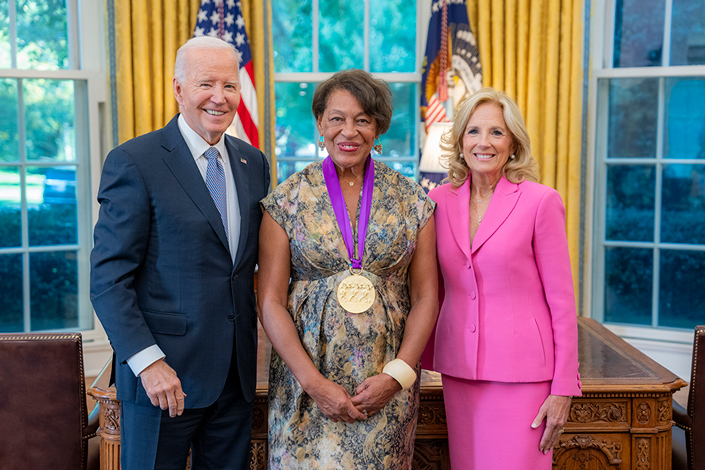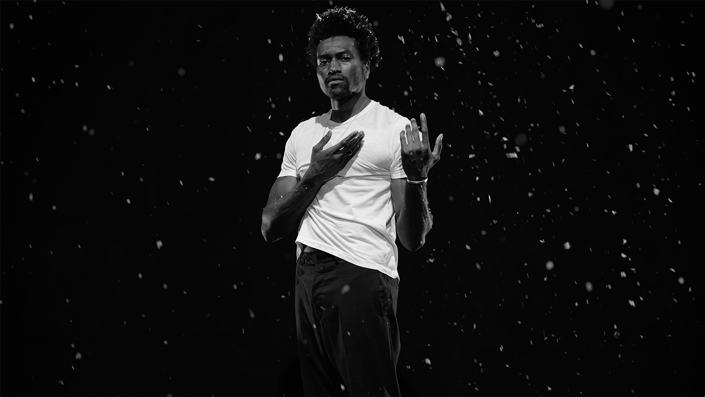UC San Diego Alumna Carrie Mae Weems Shares Hard Truths
Artist Carrie Mae Weems creates work about the meaning and implications of life.
Published Date
Article Content
This story appears in the spring 2025 issue of UC San Diego Magazine as “Truth Teller.”
For more than 40 years, artist Carrie Mae Weems, MFA ’84, has been inspired to create work that addresses big questions: Who wields power, and who is relegated to the fringes? What unites people, and what causes them to fall apart? As a deeply reflective artist who communicates through photographs, text, fabric, audio, digital images, installation and video, she has dedicated her life’s work to discovering her purpose and telling the truths of our complex world — from giving voice to people whose stories have been silenced to casting a light on moments of gross injustice.
“Ultimately, I’m an artist who’s simply asking myself a set of questions about the time and the moment in which we live and its meaning and implications,” says Weems. “My first priority is to understand what I’m doing here on the planet. And when I leave here, I can say that I tried to explore the world in a way that I thought was deeply meaningful and important to myself, and by extension, to others.”
In October 2024, Weems was presented with the National Medal of Arts, the highest honor given to artists by the federal government for outstanding contributions to the excellence, growth, support and availability of the arts in the United States. The latest honor joins her extensive list of accolades, which include a Hasselblad Award, MacArthur Fellowship, U.S. State Department Medal of Arts and seven honorary doctorates, to name a few.
Weems was taken aback when she learned about receiving the National Medal of Arts. “I was profoundly honored to receive it and to be the first African American woman visual artist to receive it. It was rare and special to be invited into not only the White House but also the Oval Office, to shake the hand of the president of the United States, to greet the First Lady and to stand in this room of great history.”
A right to be
Weems’ creative spark began as a child and was kindled by her parents. In addition to drawing and painting early on, she also attended a summer theater program and joined a modern dance company. Later, she was introduced to photography by her then-boyfriend who gave her a camera for her birthday.
Looking back, Weems acknowledges that this encouragement from loved ones affirmed her decision to become a professional artist. “When I was about 20 years old, I remember my mother calling me to say that she wished she had done with her life what I was doing with my own, which was an extraordinary compliment because I was doubtful,” says Weems. “To have somebody in your corner who simply believes in you and encourages you to go for your dreams, regardless of whether they get it or not, that’s a blessing.”

A strong sense of worthiness and equality was also instilled in Weems by her father. He would explain to her that she had a right to explore, participate and be in all spaces. “It’s been a constant theme in the work I make, and I’m sure it’s borne from the lessons and the life I lived as a young person,” shares Weems. “To feel comfortable in the world, to know you have a right to be, I can’t even begin to say how important that is for me and for everyone.”
Her passion for art led her to earn a bachelor’s degree at the California Institute of the Arts in Santa Clarita. After graduating and moving into a studio, she received a surprise visit from UC San Diego Department of Visual Arts faculty member Ulysses Jenkins. He invited her to explore the campus’s burgeoning Master of Fine Arts (MFA) program. She joined him for a tour and was immediately captivated by the energy of the faculty and students.
“I fell in love with the possibility that I could continue my studies in a semi-professional way and have the support that I needed in order to make work and have it discussed and challenged in a serious way,” says Weems.
“To feel comfortable in the world, to know you have a right to be, I can’t even begin to say how important that is for me and for everyone.”
The Department of Visual Arts, part of the School of Arts and Humanities, was a dynamic place to be when Weems arrived in 1981, with distinguished conceptual artists forging the way, such as Paul Brach, Helen and Newton Harrison, and David and Eleanor Antin. These artists designed the MFA curriculum around theoretical and critical issues, an approach that diverged from traditional university art programs at the time.
“The MFA program as a course of study, extending one’s education in the arts, was fairly new,” explains Weems. “I was part of an emerging class of young people, artists, who were starting to look very seriously at advancing the MFA model.”
Finding her voice
Graduate school was a time for Weems to discover and hone her voice on topics she felt strongly about, including history, identity and power. She created dialogue about these subjects in her thesis project and first major body of work, “Family Pictures and Stories.” The project was inspired by writer and anthropologist Zora Neale Hurston, whose stories centered on the vernacular experiences of African American people in the South. The work was in response to a controversial 1965 report that cited the need to resolve a “crumbling” family structure among Black communities.
In “Family Pictures and Stories,” Weems captured moments of joy, connection and everyday interactions among family members, from a reunion event at the park to children wading in water on a warm day. The candid images, written text and audio recordings presented a realistic account of Black family life in the U.S. in a manner that was both personal and broadly representative.

Like many of her following works, the project challenged and helped reshape dominant political and cultural narratives. “Along with the social ideas we were studying at UC San Diego, it was a culmination of reading, thinking and looking at what it meant to be Black in America, understanding I didn’t need to look far afield, that I could turn to my family to understand the vernacular,” says Weems.
Decades later, the project remains as relevant as it was then. “‘Family Pictures and Stories’ is only now really beginning to be shown in a very serious way,” she adds. “It’s taken 40 years for people to catch up with the depth of the project.”
Looking for signs
Today, Weems’ family remains central to her work, serving as a means to explore ideas that matter to her. One of her latest projects, a 25-minute video installation titled “Leave, Leave Now!” investigates the story of her paternal grandfather, Frank Weems, blending historical narrative with a call for justice.
A sharecropper in Earle, Arkansas in the 1930s, Frank joined the Southern Tenant Farmer’s Union — one of the South’s first unions open to all races. At a time when sharecroppers and farmers made just 75 cents per day, the goal was to demand better subsidy arrangements from landowners, yet his activism came with significant personal risk.
After barely surviving a brutal assault by a mob in 1936, he made his way on foot to Chicago, where he filed a lawsuit against his assailants. In “Leave, Leave Now!” Weems reflects on the lasting impact of her grandfather’s forced migration — from his physical suffering to emotional trauma and the broken dreams that followed —and calls for retroactive justice. Frank’s story represents many of Weems’ family members who were part of the Great Migration, a time period when millions of Black Americans moved from the rural South to cities in the North and West.
Her video installation is part of “The Heart of the Matter,” a new exhibition that opened in April at the Gallerie d’Italia in Turin, Italy. The show also features photographic works, video projects and sculptures from her 40-year career.
“I have a platform to share certain kinds of ideas,” says Weems. “Showing in major institutions has given me the privilege to widen the field, not just for other artists, but for a public looking for signs of themselves.”

Stay in the Know
Keep up with all the latest from UC San Diego. Subscribe to the newsletter today.





